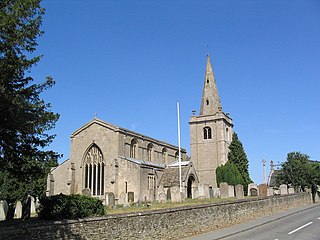
Witham on the Hill is a village and civil parish in the South Kesteven district of Lincolnshire, England. The population of the civil parish was 260 at the 2011 census.

St Mary's Church, Stamford is a parish church in the Church of England, located in Stamford, Lincolnshire, lending its name to St Mary's Hill on which it stands, and which runs down to the river crossing opposite The George Hotel.
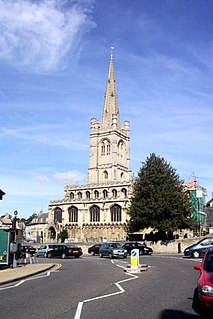
All Saints' Church, Stamford is a parish church in the Church of England, situated in Stamford, Lincolnshire, England. It is a Grade I listed building. The church is on the north side of Red Lion Square which was part of the route of the A1 until the opening of the Stamford bypass in 1960.

Edward James Willson, F.S.A., (1787–1854) was an English architect, antiquary, architectural writer, and mayor of Lincoln in 1851–2.

James Fowler, known as 'Fowler of Louth', is best known as a Victorian English church architect and associated with the restoration and renovation of churches. However, he was also the architect of a wide variety of other buildings. A listing of his work compiled in 1991 traced over 210 buildings that he designed or restored. He is known to be the architect for 24 new churches and his work also included 40 vicarages or rectories, 13 schools, four almshouses, a Savings Bank, a convalescent home and hospital as well as country houses and estate housing. Most of Fowler’s work was in Lincolnshire and particularly around Louth, but he also worked in the East Riding of Yorkshire, Nottinghamshire, Staffordshire, Suffolk, London, Sussex and Devon.

William Adams Nicholson (1803–1853) was an English architect who worked in Lincoln and was a founding member of the Royal Institute of British Architects.

Charles Kirk (1791–1847) was a builder and architect who worked on many buildings in Sleaford and South Lincolnshire, England.
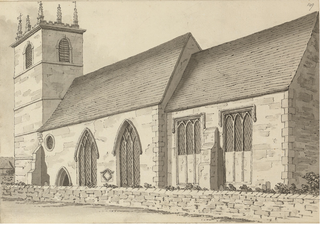
St Martin's Church was among the oldest churches in the city of Lincoln, England. It has been suggested that during the Anglo-Saxon Period and during the Danelaw, St Martin was considered to be the patron saint of Lincoln. The church is likely to have been associated with the rare St Martin silver pennies minted in Lincoln, probably before 918 A.D, when Lincoln was taken back from the Danes by the Anglo-Saxons.
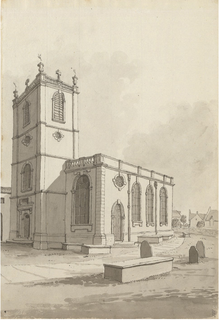
St Peter at Arches, Church, Lincoln was an ancient church in Lincoln, England, that was demolished and re-built c. 1720–24 by either Francis or William Smith of Warwick. The church was sited just to the north of the junction of the High Street and Silver Street and close to the Guildhall and Stonebow, Lincoln.

Abraham Haywood (1692–1747) was an architect who was born at Whitchurch, Shropshire and is likely to have come to Lincoln around 1720 to work for Francis Smith of Warwick on the construction of St Peter at Arches Church, Lincoln. In 1736 he built the town house of the Disney family, Disney Place in Eastgate Street, Lincoln and in 1744 the Lincoln Assembly Rooms in the Bail, Lincoln. He also built a house for himself on the east side of St Peter at Arches‘ graveyard on the site of the Lincoln Taylor's Hall. Abraham Hayward's younger brother John Hayward (1708-78), a mason by trade, also accompanied him to Lincoln. After Abraham's death, he presumably continued the business and in 1753 rebuilt St Mary's bridge in Lincoln. John Hayward's grandson, William Hayward became surveyor to Lincoln Cathedral.

William Haywood was an architect who worked in Lincoln, England. His father John who died in 1817 was mayor of Lincoln twice and worked as a mason. Haywood succeeded his father as mayor after his death in 1817. His grandfather, John Hayward (1708–78) was also a mason in Lincoln. William Hayward's great grandfather was Abraham Haywood an architect of Whitchurch, Shropshire who came to Lincoln around 1720. William Haywood succeeded William Lumby as Surveyor to Lincoln Cathedral in 1799 and Edward James Willson followed him in this position in 1823. William Hayward also succeeded William Lumby as Surveyor for the Lincolnshire County County Committee, which had responsibility for Lincoln Castle and the prison. Howard Colvin considered Hayward to be a competent designer in the ‘Regency’ style and that from the re-construction of Kirton in Holland church in 1804 had an understanding of Gothic architecture quite remarkable at that date. Hayward also rebuilt the tower of Wrangle church in a similar style in 1820.

Michael Drury was an English architect working in Lincoln.
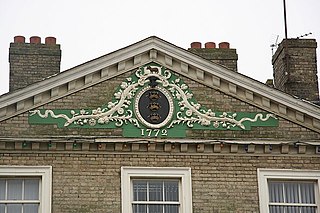
Thomas Lumby and William Lumby (c1755-1804) were master carpenters and architects working in Lincoln in the latter part of the 18th century. Thomas Lumby was the father of William. As they worked together and there is some confusion as which buildings each of them designed, they have been grouped together. It seems likely that after 1784, William Lumby had taken the business over from his father. Thomas Lumby undertook work at a number of major houses in Lincolnshire including Doddington Hall and Burghley House as well as building Caenby Hall and Corporation House (now the Exchange at Boston, Lincolnshire.

Thomas Espin (1767–1822) was an English schoolmaster, mathematician, topographical artist, antiquary and amateur architect, who spent most of his life at Louth in Lincolnshire.

John Langwith, Sr. was an English carpenter and architect who worked in Grantham, Lincolnshire. His son John Langwith Jr. (c1753-1825) was also an architect who worked in Grantham.

John Langwith Jr. (c.1753-1825) was an architect and builder who worked in Grantham. He was the son of John Langwith, Senior (c.1723-1795) and the architectural practice was continued in Grantham by his son Joseph Silvester Langwith (1787-1854). John Langwith junior was declared bankrupt in February 1795 but paid the debt off in dividends and was discharged. By 1820, he is described as Gentleman and served as Mayor and Alderman of Grantham.

Edward Browning was an English architect working in Stamford.
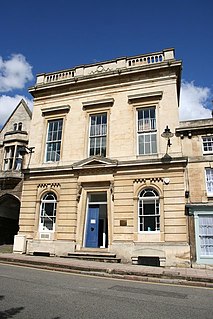
Bryan Browning (1773–1856) was an English architect working in Stamford.

Jeptha Pacey was an architect, surveyor and building contractor working in Boston in Lincolnshire. Pacey was working as an architect at 10 Witham Place in Boston in 1826.

Charles John Carter was an architect and surveyor working in Louth, Lincolnshire. Sir Howard Colvin suggests that he may have come to Louth from Brereton in Staffordshire around 1832. Most of the work that he undertook was the building or restoration of churches and designing rectories and vicarages. He also appears to have been closely connected with the laying out and construction of houses at Cleethorpes, following the Enclosure Act in 1842. This was a period of rapid development at Cleethorpes, as it developed into a popular sea bathing resort. He had a house in Upgate, Louth and also an office in Westgate, Louth. He was a great collector of antiquities and had an extensive architectural library and collection of drawings. Following his death an auction sale was held of his possessions, which lasted for four days. Following his death, he may have been succeeded in his Louth practice by Maughan and Fowler.





















